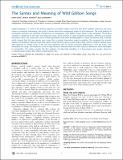Files in this item
The syntax and meaning of wild gibbon songs
Item metadata
| dc.contributor.author | Clarke, Esther | |
| dc.contributor.author | Reichard, Ulrich H. | |
| dc.contributor.author | Zuberbuehler, Klaus | |
| dc.date.accessioned | 2010-12-02T11:59:51Z | |
| dc.date.available | 2010-12-02T11:59:51Z | |
| dc.date.issued | 2006-12-20 | |
| dc.identifier | 357246 | |
| dc.identifier | f179cc22-b98c-41fe-8efd-5711e37fc92e | |
| dc.identifier | 000207443600073 | |
| dc.identifier | 40149104013 | |
| dc.identifier.citation | Clarke , E , Reichard , U H & Zuberbuehler , K 2006 , ' The syntax and meaning of wild gibbon songs ' , PLoS One , vol. 1 , no. 1 , e73 , pp. - . https://doi.org/10.1371/journal.pone.0000073 | en |
| dc.identifier.issn | 1932-6203 | |
| dc.identifier.other | standrews_research_output: 15739 | |
| dc.identifier.other | ORCID: /0000-0001-8378-088X/work/64360693 | |
| dc.identifier.uri | https://hdl.handle.net/10023/1587 | |
| dc.description.abstract | Spoken language is a result of the human capacity to assemble simple vocal units into more complex utterances, the basic carriers of semantic information. Not much is known about the evolutionary origins of this behaviour. The vocal abilities of non-human primates are relatively unimpressive in comparison, with gibbon songs being a rare exception. These apes assemble a repertoire of call notes into elaborate songs, which function to repel conspecific intruders, advertise pair bonds, and attract mates. We conducted a series of field experiments with white-handed gibbons at Khao Yai National Park, Thailand, which showed that this ape species uses songs also to protect themselves against predation. We compared the acoustic structure of predatory-induced songs with regular songs that were given as part of their daily routine. Predator-induced songs were identical to normal songs in the call note repertoire, but we found consistent differences in how the notes were assembled into songs. The responses of out-of-sight receivers demonstrated that these syntactic differences were meaningful to conspecifics. Our study provides the first evidence of referential signalling in a free-ranging ape species, based on a communication system that utilises combinatorial rules. | |
| dc.format.extent | 10 | |
| dc.format.extent | 602602 | |
| dc.language.iso | eng | |
| dc.relation.ispartof | PLoS One | en |
| dc.subject | QL Zoology | en |
| dc.subject | GN Anthropology | en |
| dc.subject.lcc | QL | en |
| dc.subject.lcc | GN | en |
| dc.title | The syntax and meaning of wild gibbon songs | en |
| dc.type | Journal article | en |
| dc.contributor.institution | University of St Andrews. School of Psychology and Neuroscience | en |
| dc.contributor.institution | University of St Andrews. Institute of Behavioural and Neural Sciences | en |
| dc.contributor.institution | University of St Andrews. Centre for Social Learning & Cognitive Evolution | en |
| dc.identifier.doi | https://doi.org/10.1371/journal.pone.0000073 | |
| dc.description.status | Peer reviewed | en |
| dc.identifier.url | http://www.scopus.com/inward/record.url?scp=40149104013&partnerID=8YFLogxK | en |
This item appears in the following Collection(s)
Items in the St Andrews Research Repository are protected by copyright, with all rights reserved, unless otherwise indicated.

